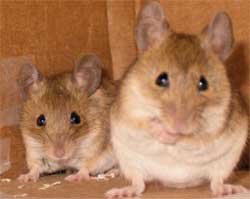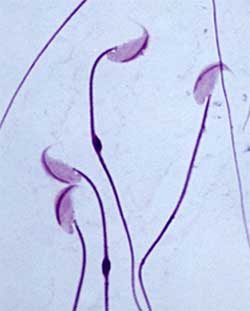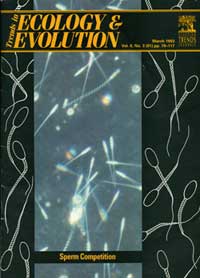Research

Our research on gamete evolution, speciation, interspecific fertilisation, hybridisation, and reproductive isolation has allowed us to understand mechanisms of chromosomal evolution in South American rodents, and the role of gametic isolation in several species of rodents (Merani et al. 1983, Roldan et al. 1984, 1985, Vitullo et al. 1988, Roldan and Yanagimachi 1989, Gomendio and Roldan 1994). We have analysed the evolution of mammalian spermatozoa, examining patterns of change in head structures and in the size of the flagellum, and examined the potential role of underlying selective forces (Roldan et al. 1992).
 We
study how sexual selection operates after copulation. When females copulate
with more than one male during a single sexual cycle, ejaculates from
rival males compete within the female reproductive tract (i.e., sperm
competition) and females may influence the fertilisation success of different
males (i.e., cryptic female choice). Sperm competition is a potent evolutionary
force which has influenced a broad range of male reproductive traits.
An almost universal response to increased levels of sperm competition
is an increase in the number of spermatozoa produced and it has long been
assumed that there is a trade-off between sperm numbers and sperm size.
We proposed for the first time that sperm competition should also favour
an increase in sperm size and, in particular, an enlargement of the flagellum,
since this would increase sperm swimming speed and maximise the chances
that a male would win the race to fertilise the ova (Gomendio and Roldan
1991). A comparative study among mammals supports the hypothesis that
males in species with high levels of sperm competition have longer spermatozoa
(Gomendio and Roldan 1991).
We
study how sexual selection operates after copulation. When females copulate
with more than one male during a single sexual cycle, ejaculates from
rival males compete within the female reproductive tract (i.e., sperm
competition) and females may influence the fertilisation success of different
males (i.e., cryptic female choice). Sperm competition is a potent evolutionary
force which has influenced a broad range of male reproductive traits.
An almost universal response to increased levels of sperm competition
is an increase in the number of spermatozoa produced and it has long been
assumed that there is a trade-off between sperm numbers and sperm size.
We proposed for the first time that sperm competition should also favour
an increase in sperm size and, in particular, an enlargement of the flagellum,
since this would increase sperm swimming speed and maximise the chances
that a male would win the race to fertilise the ova (Gomendio and Roldan
1991). A comparative study among mammals supports the hypothesis that
males in species with high levels of sperm competition have longer spermatozoa
(Gomendio and Roldan 1991).  Sperm competition, however, does not seem to explain all the variability
found in sperm numbers and size. Additional studies have shown that female
reproductive traits (e.g., duration of the interval between the beginning
of oestrus and ovulation, size of the female reproductive tract) are associated
with sperm numbers, size and longevity, showing that there is co-evolution
between male and female reproductive traits (Gomendio and Roldan 1993a).
We have emphasised that a better understanding of the physiological mechanisms
underlying sperm competition can improve adaptive explanations of reproductive
strategies (Gomendio and Roldan 1993b). Sperm competition was thought
to be rare among mammals, mainly because males seem efficient at mate
guarding and spermatozoa are short lived; however, a review of the literature
shows that sperm competition is indeed widespread in this group (Gomendio
et al. 1998). These findings have allowed us to elaborate a theoretical
model which, based on the evidence that the Y chromosome contains genes
related to sperm production and dimorphic traits, proposes that sexual
selection in mammals may have favoured traits which improve the competitive
ability of males both before and after copulation, even if these are costly
to females, because the Y chromosome spreads unaltered through the male
line (Roldan and Gomendio 1999).
Sperm competition, however, does not seem to explain all the variability
found in sperm numbers and size. Additional studies have shown that female
reproductive traits (e.g., duration of the interval between the beginning
of oestrus and ovulation, size of the female reproductive tract) are associated
with sperm numbers, size and longevity, showing that there is co-evolution
between male and female reproductive traits (Gomendio and Roldan 1993a).
We have emphasised that a better understanding of the physiological mechanisms
underlying sperm competition can improve adaptive explanations of reproductive
strategies (Gomendio and Roldan 1993b). Sperm competition was thought
to be rare among mammals, mainly because males seem efficient at mate
guarding and spermatozoa are short lived; however, a review of the literature
shows that sperm competition is indeed widespread in this group (Gomendio
et al. 1998). These findings have allowed us to elaborate a theoretical
model which, based on the evidence that the Y chromosome contains genes
related to sperm production and dimorphic traits, proposes that sexual
selection in mammals may have favoured traits which improve the competitive
ability of males both before and after copulation, even if these are costly
to females, because the Y chromosome spreads unaltered through the male
line (Roldan and Gomendio 1999).  We
are currently investigating how sperm competition has shaped the evolution
of reproductive traits in a group of closely related species of rodents,
including aspects of sperm function which so far have not been explored.
We are also analysing how sperm competition may have influenced the
evolution of proteins important for sperm function at fertilization,
especially those involved in sperm-egg interaction.
We
are currently investigating how sperm competition has shaped the evolution
of reproductive traits in a group of closely related species of rodents,
including aspects of sperm function which so far have not been explored.
We are also analysing how sperm competition may have influenced the
evolution of proteins important for sperm function at fertilization,
especially those involved in sperm-egg interaction.
Collaborators:
• Juan Ausio, Department of Biochemistry and Microbiology,
University of Victoria, Victoria, BC (Canada)
• Dan Hardy, Department of Cell Biology & Biochemistry, Texas
Tech University Health Sciences Center, Lubbock, TX
(USA)
Back to projects